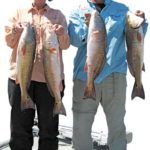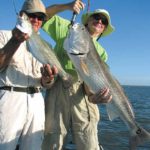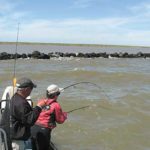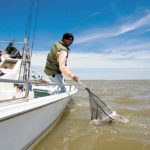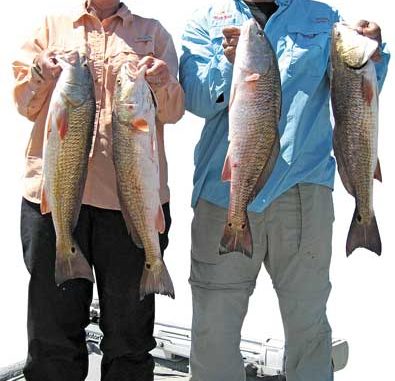
There are no guarantees in fishing, but the South Pass jetties are about as close as it gets.
First-timers fishing Venice without the services of a guide often feel a sense of impending doom when they reach Head of Passes.
With so many passes, bayous and canals that mirror every other pass, bayou and canal, Venice newbies frequently get a sense of what it must have been like for early French explorers who often missed the mouth of the Mississippi River by miles.
Missed turns and unfound fishing holes lead to empty ice chests. And anglers who one time wondered if they could get there from here wonder if they can get here from there.
Although it’s often like this for Venice virgins, it doesn’t have to be.
Keep it simple, stupid. How much more simple could it get at Venice than driving directly to a “guaranteed” spot without even having to turn your steering wheel?
If you can make it from Venice Marina to the Mississippi River, your navigation worries will be over as long as you run straight down the river.
“The rock jetties at the end of South Pass are outstanding places to catch redfish,” said Capt. Shawn Lanier with Fish-On Guide Service. “The end of South Pass is easy to find, easy to get to, and the fish are there.”
Although the end of South Pass is an easy, albeit lengthy, trip, as Lanier mentioned, his fellow Venice guide and South Pass regular Capt. Keith Kennedy with Born to Fish Charters acknowledged that anglers sometimes get confused at Head of Passes.
“Those rocks are a very popular spot,” he said, “and people who don’t really know the area that well like to head down that way. Although it’s a straight shot down South Pass from Head of Passes, those who aren’t familiar with the area have a tendency to turn up Pass a Loutre for some reason. Pass a Loutre looks a lot like South Pass, so I guess that’s what throws some people off.”
I recently rode along with Lanier to see what the South Pass rock jetties were all about. Lanier and his clients smoked the reds the day before our trip, and they graciously invited Kennedy to move in on the action. On this day, it was Kennedy’s turn to return the favor.
As we closed the distance between Redfish Bay and South Pass, we could intermittently spot Kennedy’s boat already anchored off the rocks. Like a mirage that disappeared as soon as it appeared, Kennedy was there one second and gone the next. The rollers swelling up from the Gulf of Mexico held our answer.
Desperately trying to keep his boat at a distance, Lanier sought instructions as to how we should set up and anchor. Although his boat was violently riding each swell up and down, Kennedy had to stop every few words to land and unhook another redfish. We moved about 30 yards away, and set up shop.
“The rocks area always a place to give it a try. They attract so many baitfish,” Lanier made clear over the roar of the crashing surf on the nearby beaches. “Whatever attracts bait attracts fish — lots of big reds down here. Bull reds up to 40 inches roam these rocks in June. No doubt the hosses are here.”
As if watching the two fellows fishing out of the back of Kennedy’s boat weren’t enough proof, Lanier shoved a rod toward me that was twisted in its own Carolina-rig. I spun the rod a few times before impaling a live shrimp right below its horn, but not in the black spot, and made a long cast toward the rocks.
Turns out, we weren’t in the spot, but we were pretty darn close. Kennedy’s boat was landing five reds to our one, but according to both guides, that’s just the way it is on the rocks.
“It was just the opposite yesterday,” Kennedy told me later. “Shawn was in the hot spot, and we were just poking along. Reds can be anywhere up and down these rocks, but where the thick schools of reds are depends on where the bait is.”
By June, Kennedy says the water clears up well, and anglers can spot big schools of pogies and mullet making their commotions on the surface. Farther out toward the ends of the jetties where the water is deeper, he recommended looking for balls of bait on your depth-finder before deciding where to throw out your anchor.
Buck Perry, the widely acknowledged “Father of Structure Fishing” in the bass fishing world, used to have a saying about how easy it was to find bass.
“They’re shallow, deep or somewhere in between,” he used to surmise.
Kennedy has a similar saying for the South Pass rock jetties.
“The reds will be at the end, on the beach or somewhere in between,” he said. “If the wind is blowing, you’re kind of forced to pick a spot, anchor and fish. Then you’ve got to pick up and do it again if you’re not on fish. Wind usually isn’t a problem during June — dead calm and hot as hell out there — so you can stay on the trolling motor until you find them.”
Finding reds on the rocks by identifying baitfish location is the first, and most important, component of fishing the South Pass jetties. Next, anglers have to figure out what the redfish want to eat. More often than not, they aren’t very picky.
Lanier and Kennedy are keen on fishing live bait or market shrimp, and anglers who bring both along are sure to catch something. The only problem with fishing the real stuff is that “something” will likely include a lot of hardhead catfish — especially during the summer months.
Both anglers fish live or market bait one of three ways — either on the bottom with a Carolina rig, near the surface under a popping cork or suspended somewhere in between under a sliding cork.
“It’s hard to beat live bait, but artificial lures work well, too,” Lanier added. “I like throwing the MirrOdine or soft plastics either tightlined or under a popping cork. And there are lots of calm mornings when you can get a lot of action with a topwater.”
Although he rarely strays from live bait, Kennedy says if the reds are really active and chasing bait, he likes to try a Rat-L-Trap or gold spoon.
As good as the fishing can be on the outside of the South Pass rock jetties, it’s just as bad on the inside. At least that what Kennedy believes because in all his years of fishing these rocks, he has never seen anybody fishing the inside of the rocks.
“Nobody fishes the inside at South Pass,” he said. “Don’t ask me why. Maybe the current is too strong. But over the years, and I’m talking about a long time, I’ve never seen anybody fishing in there. Over at Southwest Pass, you’ll see people fishing inside the rocks, but, for some reason, not over here.”
Other than locating baitfish and figuring out what to throw, the only other factor to sort out to be successful is figuring out when to fish. As it is everywhere else along coastal Louisiana, fishing the right tide will make even the unluckiest angler triumphant.
Lanier and Kennedy prefer to fish a falling tide as opposed to a rising tide. Both have noticed that falling water pulls more bait out of the marsh and drags it along the rocks and nearby beaches.
“Congregations of bait lead to congregations of fish,” Kennedy said. “And that’s exactly what the South Pass rock jetties do — congregate bait and fish. Fish around until you find the bait, and you’ll find the reds. The easiest thing to do is start on the beach and fish toward the end. You’ll stumble across the fish sooner or later.”
The rocks at the end of South Pass are just right for inexperienced Venice anglers who are looking to keep it simple. And the best thing is that you can get there from here without having to worry about getting back. U
Contact Capt. Shawn Lanier at (225) 205-5353 and Capt. Keith Kennedy at (504) 908-3108). Follow the author’s blog at www.chrisginn.com.
